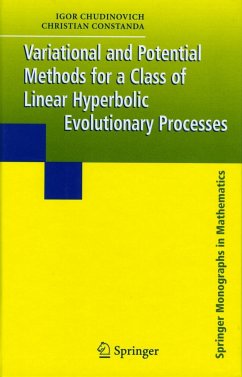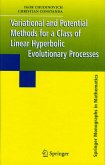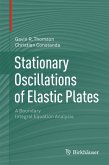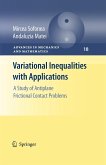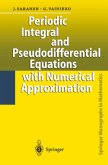The book presents variational methods combined with boundary integral equation techniques in application to a model of dynamic bending of plates with transverse shear deformation. The emphasis is on the rigorous mathematical investigation of the model, which covers a complete study of the well-posedness of a number of initial-boundary value problems, their reduction to time-dependent boundary integral equations by means of suitable potential representations, and the solution of the latter in Sobolev spaces.
The analysis, performed in spaces of distributions, is applicable to a wide variety of data with less smoothness than that required in the corresponding classical problems, and is very useful for constructing error estimates in numerical computations. This illustrative model was chosen because of its practical importance and some unusual mathematical features, but the solution technique can easily be adapted to many other hyperbolic systems of partial differential equations arising in continuum mechanics.
Variational and boundary integral equation techniques are two of the most useful methods for solving time-dependent problems described by systems of equations of the form 2 ? u = Au, 2 ?t 2 where u = u(x,t) is a vector-valued function, x is a point in a domain inR or 3 R,and A is a linear elliptic di?erential operator. To facilitate a better und- standing of these two types of methods, below we propose to illustrate their mechanisms in action on a speci?c mathematical model rather than in a more impersonal abstract setting. For this purpose, we have chosen the hyperbolic system of partial di?erential equations governing the nonstationary bending of elastic plates with transverse shear deformation. The reason for our choice is twofold. On the one hand, in a certain sense this is a "hybrid" system, c- sistingofthreeequationsforthreeunknownfunctionsinonlytwoindependent variables, which makes it more unusual-and thereby more interesting to the analyst-than other systems arising in solid mechanics. On the other hand, this particular plate model has received very little attention compared to the so-called classical one, based on Kirchho?'s simplifying hypotheses, although, as acknowledged by practitioners, it represents a substantial re?nement of the latter and therefore needs a rigorous discussion of the existence, uniqueness, and continuous dependence of its solution on the data before any construction of numerical approximation algorithms can be contemplated.
The analysis, performed in spaces of distributions, is applicable to a wide variety of data with less smoothness than that required in the corresponding classical problems, and is very useful for constructing error estimates in numerical computations. This illustrative model was chosen because of its practical importance and some unusual mathematical features, but the solution technique can easily be adapted to many other hyperbolic systems of partial differential equations arising in continuum mechanics.
Variational and boundary integral equation techniques are two of the most useful methods for solving time-dependent problems described by systems of equations of the form 2 ? u = Au, 2 ?t 2 where u = u(x,t) is a vector-valued function, x is a point in a domain inR or 3 R,and A is a linear elliptic di?erential operator. To facilitate a better und- standing of these two types of methods, below we propose to illustrate their mechanisms in action on a speci?c mathematical model rather than in a more impersonal abstract setting. For this purpose, we have chosen the hyperbolic system of partial di?erential equations governing the nonstationary bending of elastic plates with transverse shear deformation. The reason for our choice is twofold. On the one hand, in a certain sense this is a "hybrid" system, c- sistingofthreeequationsforthreeunknownfunctionsinonlytwoindependent variables, which makes it more unusual-and thereby more interesting to the analyst-than other systems arising in solid mechanics. On the other hand, this particular plate model has received very little attention compared to the so-called classical one, based on Kirchho?'s simplifying hypotheses, although, as acknowledged by practitioners, it represents a substantial re?nement of the latter and therefore needs a rigorous discussion of the existence, uniqueness, and continuous dependence of its solution on the data before any construction of numerical approximation algorithms can be contemplated.
"This book deals with variational and boundary integral equation techniques applied to hyperbolic systems of partial differential equations governing the nonstationary bending of elastic plates with transverse shear deformation. Results about the variational formulation are first established in the general setting of Sobolev spaces before useful, closed-form integral representations of the solutions are sought in terms of dynamic retarded plate potentials.
Most classical problems in the field of elastic plates are considered; namely, the clamped-edge and free-edge plates involving Dirichlet and Neumann boundary conditions respectively, elastic Robin, simply supported edge plates characterized by mixed and combined displacement-traction boundary data, transmission or contact problems, plates with homogeneous inclusions, cracks and plates on a generalized elastic foundation. The general scheme is the following: once the variational formulation has been established, the solvability is studied in distributional spaces; this allows the authors to determine solutions in the form of time-dependent single-layer and double-layer potentials with distributed densities satisfying nonstationary integral equations. The resulting equations are handled by means of the Laplace transform to reduce the original problems to boundary value problems depending on some complex transformation parameter $p$. When the real part of $p$ is constrained to be positive, estimates are derived, thus allowing the authors to make conclusions about the properties of solutions. To solve the transformed problems, algebras of singular integral operators are introduced so as to take into account the boundary values of the transformed potentials. Using Parseval's identity, the spaces of originals are recovered to prove existence of weak solutions to the given initial-boundary value problems...." (Isabelle Gruais, Mathematical Reviews)
Most classical problems in the field of elastic plates are considered; namely, the clamped-edge and free-edge plates involving Dirichlet and Neumann boundary conditions respectively, elastic Robin, simply supported edge plates characterized by mixed and combined displacement-traction boundary data, transmission or contact problems, plates with homogeneous inclusions, cracks and plates on a generalized elastic foundation. The general scheme is the following: once the variational formulation has been established, the solvability is studied in distributional spaces; this allows the authors to determine solutions in the form of time-dependent single-layer and double-layer potentials with distributed densities satisfying nonstationary integral equations. The resulting equations are handled by means of the Laplace transform to reduce the original problems to boundary value problems depending on some complex transformation parameter $p$. When the real part of $p$ is constrained to be positive, estimates are derived, thus allowing the authors to make conclusions about the properties of solutions. To solve the transformed problems, algebras of singular integral operators are introduced so as to take into account the boundary values of the transformed potentials. Using Parseval's identity, the spaces of originals are recovered to prove existence of weak solutions to the given initial-boundary value problems...." (Isabelle Gruais, Mathematical Reviews)

